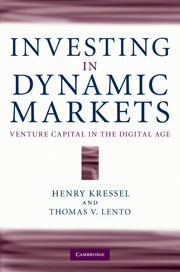Book contents
- Frontmatter
- Contents
- List of figures
- List of tables
- Acknowledgments
- Introduction
- 1 Hot markets, investment waves, bubbles, charlatans
- 2 Financing high-risk businesses
- 3 Venture investing: An uncertain science
- 4 Investing in a transformed market: Telecommunications
- 5 Investing in a transformed market: Semiconductors
- 6 Investing in early-stage technology: The Internet in the 1990s
- 7 Software products and services
- 8 Venture capital: Past and future
- Appendix
- Bibliography
- Index
6 - Investing in early-stage technology: The Internet in the 1990s
Published online by Cambridge University Press: 06 July 2010
- Frontmatter
- Contents
- List of figures
- List of tables
- Acknowledgments
- Introduction
- 1 Hot markets, investment waves, bubbles, charlatans
- 2 Financing high-risk businesses
- 3 Venture investing: An uncertain science
- 4 Investing in a transformed market: Telecommunications
- 5 Investing in a transformed market: Semiconductors
- 6 Investing in early-stage technology: The Internet in the 1990s
- 7 Software products and services
- 8 Venture capital: Past and future
- Appendix
- Bibliography
- Index
Summary
About the year 1450 some rather unusual ‘manuscripts’ made their appearance in the northern regions of Western Europe. Although not very different in appearance from traditional manuscripts, they were ‘impressed’ on paper, sometimes on vellum, with the mechanical aid of a printing press which used moveable type. The process was simple. But it was the object of considerable curiosity and fascination. In fact, these new books were to cause profound changes not only in the habits of thought but also in the working conditions of secular and religious scholars, the great readers of the time. The changes (we won't say revolution) soon broke the bounds of this original audience and made considerable impact on the world outside.
Sometimes innovations trigger industrial and social revolutions. The introduction of printing opened up new vistas on the world, as printed books and periodicals brought knowledge and thought from every corner of the earth to those who could read. Without the printed word most of the great industrial advances and social movements of the past five centuries could not have taken root.
In our time the Internet has sparked a second revolution in the exchange of ideas. Its spread from a select few to the greater public reminds me of the way printing emerged: a slow start followed by spectacular impact. While the progress of the Internet has occurred in a highly compressed timeframe compared to that of printing (20 years instead of more than 200), they both spread from a specialist audience to the general public.
- Type
- Chapter
- Information
- Investing in Dynamic MarketsVenture Capital in the Digital Age, pp. 158 - 185Publisher: Cambridge University PressPrint publication year: 2010



